For an introduction to Machines in Humanitarian Demining Click here.
Mechanical demining procedures are covered in Chapter 8 of the Global SOPs.
I have often heard that I oppose the use of machines in demining. The 'mechanical mafia' say this because I always argue when they try to use machines in an unsafe manner. From 1995 onwards (when most of the mafia were at school) I have been arguing for the use of machines in Mechanically Assisted Demining (MAD), a term coined by Hendrik Ehlers. The MAD acronym is unfortunate so I generally use the expression ‘Mechanical Demining’ to mean 'mechanically assisted demining'.
Whether by cutting undergrowth, removing obstructions or loosening the ground surface, preparing a suspected hazardous area in front of manual demining can have real advantages, described below.
Removing vegetation
By cutting undergrowth close to the ground, the exposed fuzes of fragmentation mines can often be broken or the mine initiated. Bounding fragmentation mines have killed more deminers than any other type of mine so reducing that threat before a manual search is something I recommend in overgrown areas where there may be bounding fragmentation mines. Where there is no vegetation, there usually is no need because these mines are usually partly exposed, so visible. There is compelling evidence that the use of mini-flails to remove undergrowth in the Balkans reduced the number of PROM-1 deaths dramatically (by initiating them or breaking off their fuzes). To be really useful, the machines have to be powerful enough to climb hills while cutting undergrowth and armoured well enough to protect against the blast and fragmentation associated with mines that may detonate against the machine after bounding.
Removing obstacles
By using a machine to remove obstacles such as vehicle wrecks, fallen trees or barbed wire entanglements from the working area, the deminers can work more efficiently and avoid the risk that those obstacles have explosive hazards entangled or attached.
Loosening the ground surface
By loosening the ground surface in areas where the ground is very hard, the excavations that a deminer conducts to uncover metal-detector signals or in area excavation are easier (faster) and require less force so are safer (less likely to accidentally apply pressure to the hazard). Loosening the ground surface, collecting it, then sifting it is also done in some areas. When clearing old trenches or collapsed buildings, removing the spoil and spreading it for inspection can be the only safe way to search and clear the area.
In all three uses, safety is enhanced, and the work is conducted more quickly. Whether it is cheaper depends on the cost of purchasing, transporting, running, and maintaining the machine. Generally, the only way that a large machine can be cost-efficient is when its purchase costs are amortised over several years during which it is used on many tasks, so kept busy. Generally, the larger the machine, the more expensive it is to buy, transport, maintain, and run – so the less likely it is to be cost-efficient. That should not matter if it enhances safety – and by safety I mean both the safety of the deminers and of the people who will use the land when they have finished.
Many large machines can only be presented as being cost-efficient if you pretend that they can ‘clear’ land. Most machine operators I have met do not pretend that their machine can 'clear' an area, but they are often controlled by people who do. Anyone who argues that a machine can ‘clear’ an area is seeking to reduce safety for everyone. They may have a naive trust that a technology will achieve its design ends, a fiscal relationship with the machine's maker, a desire to appear 'efficient' at all costs, or simply be ignorant of the 'clearance' requirements in Humanitarian Demining.
In 1995, I led a group from the University of Warwick (Clark Hulley and Chris Taylor) to Mozambique to find out whether there was anything our little charitable group in the Engineering Department could do to assist the deminers. In my report I identified three apparent needs: Personal Protective Equipment (PPE), blast-resistant hand tools, and a small machine to cut undergrowth in front of deminers. Even at that time, the inadequacy of large machines designed to detonate mines was well known. There had been injuries and fatalities using military breaching machines, and everyone knew that no machine could detonate the mortar bombs, grenades and other abandoned or fired ordnance that litters battle areas. Minefields were usually placed defensively so were often the scene of fighting and had become battle areas as well as minefields. The machine I suggested in 1995 was not intended to detonate anything although it would be designed to survive any small accidental detonation that occurred. It would be radio controlled and simple enough to be manufactured (assembled) near the area of use and then maintained using local vehicle repair workshops.
I looked at a lot of armoured machines made during the wars in Southern Africa and studied Peter Stiff’s Taming the Landmine book. The old Rhodesian army had been the first to develop successful mine resistant vehicles (allowing occupants to survive anti-tank mine blasts) and the South Africans had built on their work with considerable success. There were many machines in scrap yards and at military bases in Zimbabwe and South Africa that I could look at. All of these machines were too big and heavy to try to copy, but there were clever design lessons that could be incorporated into something smaller. They were too heavy because of cost, and also because the roads, bridges and infrastructure were often in very poor repair and a very heavy machine could not be easily transported to the area of need. None the less, demining groups did use huge ground engaging machines in Afghanistan, Angola and Mozambique in the early days. In Afghanistan, two HALO Trust deminers using a converted battle-tank to detonate anti-tank mines died when a mine detonated under the tank, so illustrating the rather obvious fact that even battle-tank armouring does not protect against mines designed to compromise that protection.
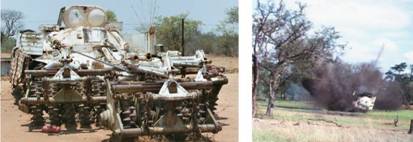
In a similar accident in Angola, a tank fitted with the Soviet KMT5 roller system was used in a barrier minefield with TM57 anti-tank mines until one detonated under the tank, killing one of the occupants. The picture on the right above shows the tank being thrown in the air when the accident occurred (it was being filmed at the time).
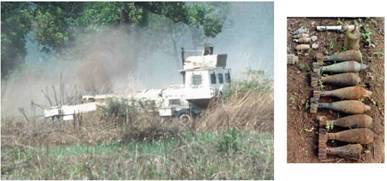
When I collected visible ordnance (including mines) after this Aardvark flail had been used in Angola and the area declared ‘clear’ my concerns were dismissed by the programme manager. He argued that the country was still at war and that doing something was better than nothing. I disagreed, arguing that people would use the land after the machine has passed thinking that it was safe, so he was increasing their risk. He shrugged. Well, he was Havard Bach, programme manager for Norwegian People’s Aid (NPA) in Angola and I was a novice. Surely he would not have been given such a responsible job unless he knew more than me? Havard was a pleasant man with a lovely Mozambican wife and adopted child (they once came to stay in my home) so I thought that I must be misunderstanding something. This was before the International Standards had been formulated so there were no rules for me to refer to. Havard was right that it is not always possible to work in the way that you want to during times of active conflict - but wrong because there was no fighting where the Aardvark was working at that time. One reason we needed International Standards was to prevent programme managers having to play God and make life or death decisions while recovering from yesterday’s boozy fishing trip.
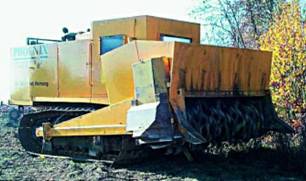
Several accidents during the use of the Krohn machine (above) in Mozambique included one when the operator was furtively collecting the mines left by the machine and stepped on one. An independent UN test found that it could not clear ground despite detonating some pressure mines (I have the test report if you would like to see it). In real minefields, no ground engaging machine detonates all pressure operated mines and they are not even intended to detonate other munitions. Far from being helpful, the Krohn machine destroyed the mine patterns and scattered damaged hazards over a wider area, increasing risk to the deminers who had to search and clear the area after the machine has finished.
Talking with the hands-on deminers, I knew that they did not like the big machines because they thought they might take their jobs away, but they wanted a machine that would cut the vegetation and so simplify their search tasks. So I designed a vegetation cutting machine that would be light enough to be transported in the back of the pick-up trucks that most demining organisations already owned. This constraint meant that it had to be lightweight. At that stage, I had not done any testing with anti-tank mines, so I optimistically thought that I might be able to make my machine able to survive an anti-tank mine blast with repairable damage.

The smallest machine that had survived anti-tank mines in a repairable condition was the Rhodesian Pookie – which used a V hull to divide and deflect any blast under the hull (an air-cooled VW beetle engine was at the rear). The wheels were spread so that a detonation under a wheel would not compromise the armoured cockpit and very wide ‘slick’ tyres were used to make it less likely that the pressure applied by a wheel would detonate a mine designed to require a heavy weight above it. Some anti-tank mines can be fitted with tilt rod fuzes that stand up from the mine body. The rod hits the underside of a passing vehicle and tilts, so the mine detonates under the vehicle rather than under the wheels or tracks. These tilt-rod fuzes are rarely used – or at least, I have never seen one outside a display case. The threat to the hull of the Pookie was from command detonated devices deliberately initiated as the machine passed. I blew the cockpit of one up in ‘99, while testing whether a film canister filled with a locally made nitro-methane explosive had the shock wave velocity to be used to detonate an unfuzed TM46 anti-tank mine. It did, and the Pookie hull jumped sideways without being compromised. The nitro-methane (NM) was a clear liquid that was simple to make and could be gelled to make it easier to handle. For security reasons, I persuaded the chemist who made it not to try to market it. When the airport security people will not let you carry liquids on board, that’s why… except that 100 millilitres of NM would easily knock a hole in the side of a plane. The security people have compromised for passenger comfort, but not necessarily wisely.
My first design of small machine copied the Pookie’s V hull and the extended wheel base. It was to be radio controlled so that the operator could be at a safe distance. To make its footprint small enough to fit into the back of a pick-up truck, secondary axles bolted to stub axles after the machine was unloaded.

It was an unusual design, but the best I could do with the knowledge I had at the time and I put in funding applications through the University of Warwick to get it built. It got some support, but not a great deal and I had broken my association with the University by the time that they raised enough money. By that time I had done some tests with anti-tank mines and seen the results of mines detonating beneath vehicles, so I knew that there was no way that a small machine could be designed to effectively survive an anti-tank mine blast. No matter how well it was armoured, it would be thrown into the air and crush itself on landing. This meant that the V hull was not necessary – a good thing because it enclosed the engine and no off-the-shelf diesel engine was V shaped. (I believed that it had to be diesel rather than petrol for safety reasons – but having seen the results of diesel fires after mine strikes, I now think that protecting the fuel tank and lines is more important than the fuel type.)
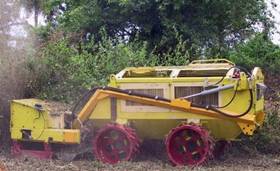
The University of Warwick engineers, poorly advised by demining ‘experts’, carried on with the V hull and overcame the fact that the engine and armouring were too heavy to allow extended axles by moving the wheels tight against the hull. This meant that any detonation under a wheel would hit the flat side of the V hull and so capture rather than divide the impact, but they had started on the challenge of fitting a square inside a V so did not change their approach. Originally called the ‘Beaver’ because its tool would eat small trees, they acknowledged American slang and renamed it the ‘Tempest’. The end result was a heavyweight disaster designed to survive an anti-tank mine. It was too heavy to drive itself up any kind of slope, and so unbalanced that it fell over on uneven ground. But it had been funded and the donors gave several of the machines to demining groups for use on flat ground. The one actual purchase I know about was made by the British manager of an NPA programme in Bosnia. That machine caught fire and burned out while working in flat Sarajevo gardens. Its instability meant that the controller had to be close by to ensure that it did not drive into a depression that could not be seen until the undergrowth was cut, so a second armoured vehicle was needed to protect the operator. The machine, its flat-bed transporter (which needed a crane because the Tempest could not climb ramps) and the second armoured vehicle for the operator meant that it cost far more to purchase and run than the MV4 mini-flail which was commercially available by that time (and was reliable, stable, and could work climbing hills). Having been involved in the original plans for this machine, I can only hang my head… but a crucial part of my original concept was that it should be light enough not to need a dedicated transport vehicle, so I can honestly claim that it no longer had anything to do with my design. Over the years it has been funded with UK government money and then US government money, so has been refined again and again, always retaining the V hull and the requirement to resist anti-tank mine detonations (which its heavy weight means that it cannot avoid if they are present). Ah well, the engineers have had fun and were well paid.
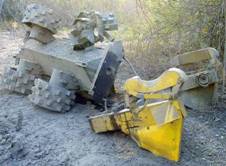
This shows the Tempest ‘surviving’ an anti-tank mine blast in a test. This is technically ‘repairable’,
but only back in the factory that made it and you would need to get a crane into the minefield to recover it.
Around the turn of the century I used my own money to make a ‘proof of concept’ of the small machine I wanted with a Lockheed Martin friend in Florida. At very low cost, I made the ‘Locust’ – but I needed rather more money to perfect it. I needed help with the radio control system and really wanted to build it again from scratch – taking advantage of what I had learned.
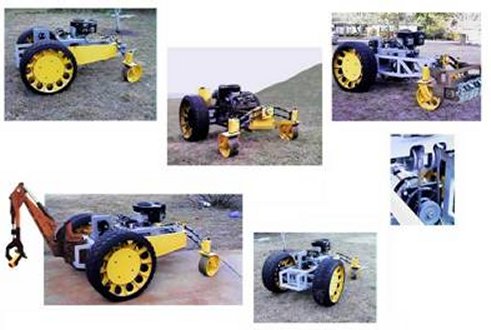
The front jockey wheels and skid steering were delightfully simple but my plan to cut the vegetation using electrically powered tools (the engine drove a generator) needed to be tested and compared with mechanical options. I wanted the generator option for field work in Africa, intending to run the machine at low revs in the evenings to light the camp and perhaps even power a shower! When the promised donor turned away, I could not afford to continue so I returned to other things. I always intended to go back to work on it again, but I did not have the skills to do it alone.
In 2004 I found myself in Iraq following an Armtrak flail that was being used to try to locate Saddam’s defensive mine-lines in the hills. According to the International Mine Action Standards (IMAS) today, a flail can be used to conduct Technical Survey in this way without any follow-up search at all.

The flail was able to climb the hills and hammered the ground quite well, but passed through a mine-line including mixed anti-personnel mines without detonating any.

On the left of this picture is a Valmara-69 bounding fragmentation mine lying on its side. Busy looking to both sides, I actually stood on that mine as we walked behind the machine, a sobering thought. With no PPE or detectors, we turned back abruptly.
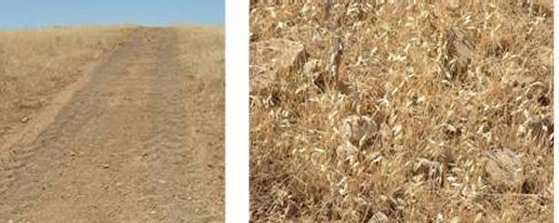
The Valmara-69 mines were actually visible on both sides of the track (you can see the crown of one on the right if you look closely). The accompanying VS50 blast mines were not visible but they were there and the flail had passed through a line of them without detonating anything. But the mechanical mafia knows best so the IMAS says that a flail can be used to find a mine-line with no follow-up at all – not even the visual follow-up that I was conducting. I have shown them many pictures of mines and ordnance left behind machines, but they are not interested. The lack of professional concern for safety amongst the self-appointed leaders of this industry is just a sad fact.
A few years later I found myself in Sri Lanka, hired by NPA, and part of my job involved assessing the improvised machines that two Indian demining NGOs wanted permission to use. The UNDP supported Mine Action Centre would not allow their use and they were right because most of the machines were unsafe.
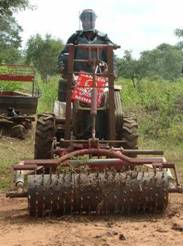
The roller in front of ths machine is covered in sharpened nails. Innovative and low-cost, but with no remote control system available, their small machines did not do what they wanted them to do – which was to clear ground – and they put the operator at risk.
The one machine concept that had real potential was designed to assist manual demining rather than replace it. This was the Arjun, a converted excavator that had been fitted with a raking tool to prepare the ground before the deminers searched and cleared an area using the manual Rake Excavation and Detection System (REDS).
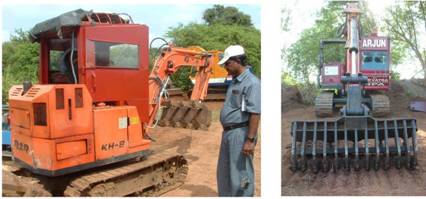
The Arjun rake could be fitted to small or large excavating machines to
prepare ground by removing undergrowth and roots before the deminer’s searched.
When I arrived, a deminer in PPE drove the machine, but no armouring had been added to the cab or to protect the vulnerable hydraulic hoses and fuel lines. They thought they were only working in anti-personnel blast mine areas, so considered the risks tolerable. I encouraged greater caution, and they got to work adding light armour, an escape hatch, fire extinguishers, radio comms, all the little extras that could make the excavator conversion acceptable to the international community. At the same time, they kept trying new tool designs, eventually optimising something very strong and simple that could both rake the ground and rip out the dense root mat at the same time. The excavator machines were purchased in the local second-user market. The modifications, including the tool and its many iterations, were all manufactured using roadside workshops where the machine could be serviced, repaired or refined at low cost without waiting for import delays.
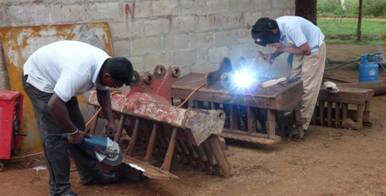

That’s me on top of the engine of a smaller Arjun as I checked whether the tool was able to sift mines from the ground as it raked.
They wanted the machine to find every mine and adjusted the tool until it did lift most mines, but they listened to my concerns and never called it a ‘clearance’ machine. See the Arjun demining system. I did not do any of the design or hands-on work, only advised and encouraged. Within six weeks of my arrival the machine was approved for use and working in mined areas. At one time, 14 were in use in Sri Lanka.

An Arjun machine could be used to rake between mature trees, as it was in this forest. The yellow topped stakes show where mines were found.

Sarvatra also made a machine to spray water into areas where the ground was very hard. For under $3k, they used a two wheeled rice-tractor to tow a water bowser and pump. It was narrow enough to drive inside any two metre safe-lane – and was the inspiration for a machine I later made in Myanmar.
Converted excavators and backhoes have also been used in other countries, usually to clean out trenches and ditches or to spread out piles of rubble. Apart from armouring, they are usually basic machines with standard excavator tools which is good because the simpler they are, the easier they are to operate and maintain. When they are built around the kind of machine that is widely used in the construction industry, this guarantees the availability of operators, mechanics, and spare parts. The machine can also be converted back to its original use when it is no longer needed in demining, so assisting with the next phase of post-conflict recovery.
The Japanese government have made several excavator-type machines specifically for removing vegetation including large trees during demining. Very heavy and difficult to move around, they have proven impossible to maintain or repair locally (they are made using specialised steels that cannot be easily welded). I do not know of any that have been purchased for use, but saw one in Cambodia and hear that they have been given to Afghanistan and Angola.

The one I saw working in Cambodia was twice the size of any Arjun and had a powered mulcher at the end of the hydraulic arm. It cost ten times what an Arjun cost and left the roots and shattered undergrowth for the deminers to remove. But countries have always liked to give ‘boomerang aid’ and the larger the machine, the more appropriate it seems to some people. In fact, a smaller machine is easier to use with the kind of precision that I like to see in a minefield.

Back in Sri Lanka, I first had an MV4 mini-flail to play with, albeit briefly, with the army, then one when I was programme manager for the Swiss INGO FSD. We used it to remove undergrowth in front of deminers along known mine lines. Occasionally it was used to cut breaches through the undergrowth that were then searched to locate the mine-lines but I stopped this because it dug itself into unseen ditches and damaged itself against large trees and in unseen wire entanglements. Running along mine-lines, it detonated very few while I was there (to be fair, the P4 mines made in Pakistan were often non-functional anyway). Useful but remarkably thirsty, the MV4 also lost a lot of flail chains and hammers even though the ground was soft. The costs included a transporter vehicle and a dedicated operator/mechanic trained by the manufacturer. Without his constant attention, the machine would not have been operational much of the time. The costs were met by our donors and having the machine did speed up some work significantly without reducing safety, but there was far more to making good use of it than people might think. Just the same, of all the mini-flails out there, I rate the MV4 by far the best and it is a useful asset in most areas with vegetation. However, despite what the manufacturer says, it cannot 'clear' any ground at all.
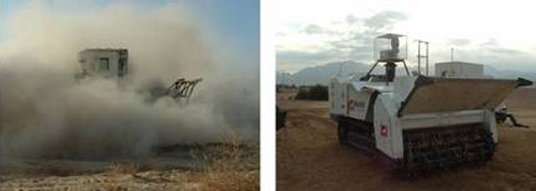
Then I got close to a MineWolf and then a mini-MineWolf while working in Jordan. Along the border between Jordan and Israel the MineWolf had been used and had pushed mines deep in the loose sand, broken some up, and destroyed a patterned minefield in which each anti-tank mine had been joined by a copper wire when they were laid. The machine has an operator inside but the dust raised was so dense that the driver relied on guidance radioed to him by an assistant standing outside the machine. Effective follow-up search behind the machine was impossible because mines had been pushed beneath detection depth and the scattered explosive from broken mines made the use of search dogs impossible. But they had the machine so the managers wanted to use it. Someone had made a very expensive decision and did not want to admit they had been (very predictably) wrong to believe the manufacturer's sales pitch.
On the border minefield between Jordan and Syria, much of the ground was rocky and the mines had been laid in disciplined patterns. We had a detailed minefield map and many of the mines were visible. This was not a task suitable for any ground engaging machine so I would have sent the mini-MineWolf away but I was not in charge. After I left, it was used in some areas to process ground outside the mine-lines to raise confidence that there was nothing there. Some mines had been moved by border hoppers but they were on the surface, so the machine added no value at all. I rate the MineWolf mechanically and think that it can be useful in some places (see the Mechanical Demining SOP) but it costs far too much and it was not useful in that minefield.
When I was UNDP Chief Technical Advisor in Tajikistan I was offered a mini-MineWolf and declined, so the donor gave it to the Tajikistan army. I turned it down because so much of Tajikistan is mountainous, inaccessible to any large machine with its transporter, and because there was no demining group with the capacity to look after it. UNDP could not work directly with the army, but OSCE could so they took over managing the machine's logistical support. I saw it being used on the river floodplains beside the border with Afghanistan where defensive minefields had become buried under silt. However, when I was last there in 2018, the army's mechanical team had been tasked with manual search and clearance because they had quickly run out of accessible places to use the machine.

A machine like this needs constant maintenance and use to be cost-efficient - but it was free and it did give the military engineers experience that they have found valuable. Did it make any of the work safer? Probably not because the minefields were accurately mapped and the mines were easy to detect. They were under 10cm of silt, but that silt was soft and easy to excavate. The costs associated with the machine's purchase, delivery, training, maintenance and fuel have run into millions of dollars that would have bought far more cleared land if it had been spent on manual demining (which the Tajik army did very well when I was there).

I cannot say that I rate the Aardvark at all. In Libya I came across several scrap-metal Aardvark flails that had been mis-sold to the Libyan army as being capable of ‘clearing’ the barrier minefield that had been laid during their war with Egypt. The flails broke some of the large PRB-M3 anti-tank mines but left most of the anti-personnel mines. When the anti-tank mines detonated, the machine was damaged. One was working with half of its flail chains missing, but the army had given up with it, recognising that they had to use manual clearance if they wanted the area to be genuinely cleared.
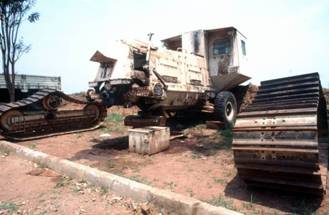
This is an NPA Aardvark awaiting repair that I had come across earlier in Angola. It has now been abandoned. The Norwegian government often paid rather heavily for the advice of its programme manager. When Havard was later ‘given’ to GICHD, the chair polishers presumed that he had field experience that made him ‘special’ and it was not long before he believed that too. Speaking English as a second language may excuse some of his sillier statements but his use of chopped logic and specious reasoning to justify blatant self-interest since he became associated with APOPO has become a bad joke to many who care about standards.
In 2010, I was asked to design the wheels and advise over the Area Preparation Tractor (APT) being made by the University of Genoa and a small company making vineyard tractors. I designed wheels that would prevent shock-wave transfer to the bearings and axles – and they used the concept to make the much heavier wheels that feature on the current machine. Despite being the size of a small car, the APT is the closest thing I have ever seen to the small machine that I originally wanted to cut undergrowth in front of deminers. It has better features than I had thought possible, but they have come at a cost. Its industrial grade remote control system coupled with on-board driving controls means that it can actually be driven to the working area by an on-board driver, so saving the cost of an expensive transporter. Its articulated chassis and steering wheels allow it to manoeuvre very tightly around obstacles. A hydrostatic gearbox allows it to move at very slow speeds with full power, or drive on roads at up to 37kph. Based on a commercially available vineyard tractor and made in a small family-owned company, the main components of the APT have been proven during long-use in harsh mountainous conditions. Perhaps because it received funding from the Italian Government and the European Union, or perhaps because its manufacturer had other priorities, its development was far slower than I can explain.
It was 2015 before the APT was ready for some independent testing which was conducted by CTRO in Croatia. The machine’s wheels were first blast tested as it drove over anti-personnel mines, then the armour was tested using fragmentation mines, and finally it was used to cut undergrowth in advance of deminers working in a forest minefield for a week. I was present while some of the testing was conducted and then stayed with the deminers throughout the field trial. See the APT video.
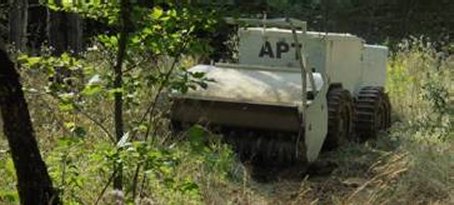
The APT’s performance impressed me and I was surprised to find that I could drive it safely within minutes of picking up the controller. It could cut small trees and dense vegetation while processing the ground surface in a way that would have broken fuzes from fragmentation mines and may have detonated anti-personnel blast mines. But its camera system was unfinished and its afterthought armouring needed to be redesigned to allow greater air circulation around the engine and to shrug off the vegetation that fell onto it as it worked.

These were minor changes but there was no money to make them. A final design was agreed with the University of Genoa and the manufacturer, but a donor to see it through has not been found (I tried, but they seem to expect the kind of lies that I find difficult). A badly worded contract between the manufacturer and the donor meant that the University of Genoa did not own the machine at the end of the project so I could not even get it delivered to my home and finish it myself.
The APT machine with its 100 HP engine and sophisticated engineering costs between $80k and 100k, which is an order of magnitude more than the low-cost machine I first envisaged. It can do far more than I anticipated and has a long life, so the increased cost can be justified. It is also versatile enough to be readily converted into a counter-IED robot – or used as an agricultural asset.
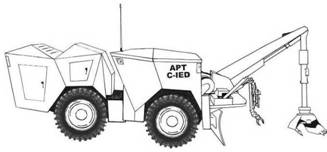
A machine like this could have been really useful in Syria, but it has not been made.
A year before the APT trial, I had been obliged to make a low-cost area preparation machine for use in Myanmar. I was with some volunteers demining the site of a school and we did not have the time to do everything manually. I needed something low-cost that could remove light undergrowth and loosen the ground surface in front of deminers who were using the Rake Excavation and Detection System (REDS). With just a few thousand dollars to spend, I had less than a month to come up with a solution in a side-of-road workshop without many tools but a lot of intelligent and skilled help. The threat was limited to small improvised anti-personnel blast mines, so I decided that I could protect the driver of my machine with distance, deflection plates, and conventional PPE.

Taking a two-wheeled rice-tractor (like Sarvatra had used for their water bowser) I made an articulated machine with a weighted spiked roller at the front (with a spiral of razor sharp spikes that cut the light undergrowth and turned the ground). There were cage wheels on the tractor, a rake array amidships and a water tank with spray along the back to damp down any dust. I made no changes to the rice tractor which was back ploughing in paddy fields two months later. The two wheeled tractor steers by skid-steering and by the farmer hauling on the long control arms. In my arrangement, the controller’s sideways movement was restricted so the steering was limited even before the spiked roller engaged the ground. With the roller on the ground, the only way was forward (or back), so the roller had to be lifted to turn (turning areas were searched manually in advance). My cage wheels sank in soft ground during the rains so it was mostly used with its road-wheels in place. This risked the tyres, but by that time people were confident that any functional pressure mines would be detonated under the spiked roller.
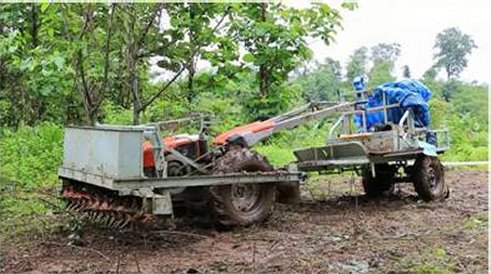
Within its limitations it did the job better than expected and quickly prepared the land for manual search and clearance. It had cost only a few thousand dollars but it could only be used on flat ground and in light undergrowth. With $10k I would have made an Arjun machine. Even better would have been an APT machine (because Myanmar is largely mountainous) but no one was going to give a bunch of maverick volunteer deminers the money for one.
So I finally got to prove that a small machine to prepare the ground in front of deminers could be made (and so maintained) locally - even by someone with no special engineering skills. I would have really liked to do it again with enough time and money to make a much better job, but that is true of everything I have ever done.
See also my work on Developing safer hand tools,
Developing body armour for demining and Developing face and eye protection. For a more complete story of my work in HD and HMA, click here.